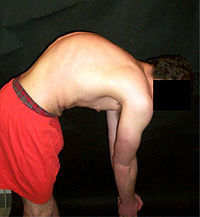
Photo from wikipedia
AIM Conservative treatment is a frequently used treatment modality for traumatic thoracolumbar fractures. However, not many studies evaluating radiological and clinical results of conservative treatment are found. The aim of… Click to show full abstract
AIM Conservative treatment is a frequently used treatment modality for traumatic thoracolumbar fractures. However, not many studies evaluating radiological and clinical results of conservative treatment are found. The aim of this study was to determine the risk factors, and compression and kyphosis rates after 1 year in patients with AO type A thoracic, thoracolumbar, and lumbar fractures treated conservatively. MATERIAL AND METHODS Radiological and clinical results of 79 thoracolumbar fractures in 57 patients, who were treated conservatively, were evaluated one year after trauma. Fractures were classified according to thoracolumbar injury classification and severity (TLICS) score and AO spinal trauma classification system. Compression rate, wedge and kyphosis angles, and sagittal index were calculated in early and late periods after trauma. RESULTS Female/male ratio was 25/32, and mean age was 41.7±16.7 years. They were followed for 15.2±4.9 months. Mean compression rates were 19.6% and 25.2%; wedge angles were 10.1 and 12.7 degrees; kyphosis angles were 5.82 and 8.9 degrees; and sagittal indexes were 8.01 and 10.13 in all patients just after trauma and after one year, respectively. Fractures in older patients ( > 60 years of age) and in patients with osteopenia or osteoporosis, located in the thoracolumbar junction, AO type A2 and A3 fractures, and solitary fractures had higher compression and kyphosis rates at last follow-up. CONCLUSION Early mobilization without bed rest for stable thoracolumbar fractures according to the TLICS system is a good treatment option, and radiological and clinical results are usually acceptable. However, fractures in patients older than 60 years, those with osteoporosis or osteopenia, fractures located in the thoracolumbar junction, solitary fractures, and fractures in AO type A2 or A3, are more inclined to increase in compression and kyphosis and may require a closer follow-up.
Journal Title: Turkish neurosurgery
Year Published: 2018
Link to full text (if available)
Share on Social Media: Sign Up to like & get
recommendations!